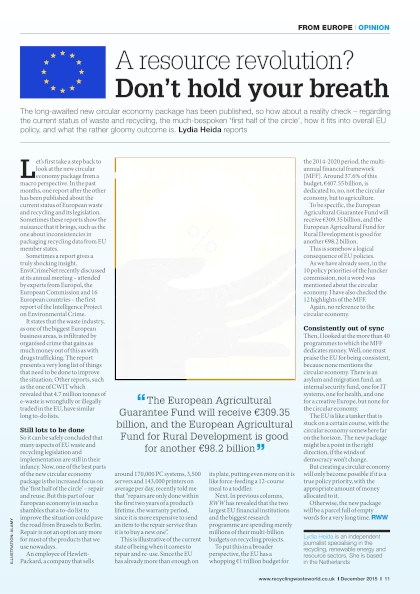A resource revolution? Don't hold your breath
The long-awaited new circular economy package has been published, so how about a reality check– regarding the current status of waste and recycling, the much-bespoken ‘first half of the circle’, how it fits into overall EU policy, and what the rather gloomy outcome is.
Let’s first take a step back to look at the new circular economy package from a macro perspective. In the past months, one report after the other has been published about the current status of European waste and recycling and its legislation.
Sometimes these reports show the nuisance that it brings, such as the one about inconsistencies in packaging recycling data from EU member states.
Sometimes a report gives a truly shocking insight. EnviCrimeNet recently discussed at its annual meeting – attended by experts from Europol, the European Commission and 16 European countries – the first report of the Intelligence Project on Environmental Crime.

Organized crime
It states that the waste industry, as one of the biggest European business areas, is infiltrated by organised crime that gains as much money out of this as with drugs trafficking.
The report presents a very long list of things that need to be done to improve the situation.
Other reports, such as the one of CWIT which revealed that 4.7 million tonnes of e-waste is wrongfully or illegally traded in the EU, have similar long to-do lists.
So it can be safely concluded that many aspects of EU waste and recycling legislation and implementation are still in their infancy. Now, one of the best parts of the new circular economy package is the increased focus on the ‘first half of the circle’ – repair and reuse.
Cost of repair
But this part of our European economy is in such a shambles that a to-do list to improve the situation could pave the road from Brussels to Berlin. Repair is not an option any more for most of the products that we use nowadays.
An employee of Hewlett-Packard, a company that sells around 170,000 PC systems, 3,500 servers and 143,000 printers on average per day, recently told me that “repairs are only done within the first two years of a product’s lifetime, the warranty period, since it is more expensive to send an item to the repair service than it is to buy a new one”.
This is illustrative of the current state of being when it comes to repair and re-use. Since the EU has already more than enough on its plate, putting even more on it is like force-feeding a 12-course meal to a toddler.
Multi-billion budgets
Next. In previous columns, RWW has revealed that the two largest EU financial institutions and the biggest research programme are spending merely millions of their multi-billion budgets on recycling projects. To put this in a broader perspective, the EU has a whopping €1 trillion budget for the 2014-2020 period, the multiannual financial framework (MFF).
Around 37.6% of this budget, €407.55 billion, is dedicated to, no, not the circular economy, but to agriculture. To be specific, the European Agricultural Guarantee Fund will receive €309.35 billion, and the European Agricultural Fund for Rural Development is good for another €98.2 billion.
This is somehow a logical consequence of EU policies. As we have already seen, in the 10 policy priorities of the Juncker commission, not a word was mentioned about the circular economy. I have also checked the 12 highlights of the MFF. Again, no reference to the circular economy. (...)
Publication: Recycling & Waste World
Date: December 2015
Would you like to read the entire article? If so, please let me know!
CONTACT MEHow Ecover plans to create the Ocean Bottle
Read More

Action’s needed, but talk is almost all there is

Worrying numbers put CEP into perspective
Interested in working together?
I'd love to hear from you.